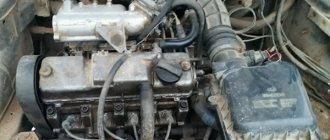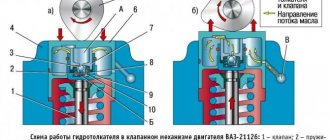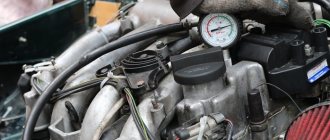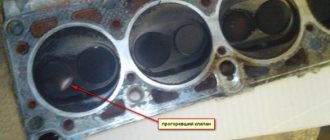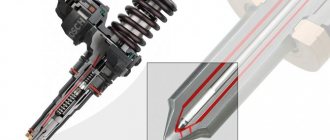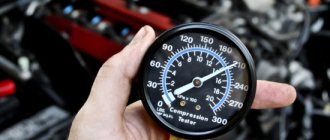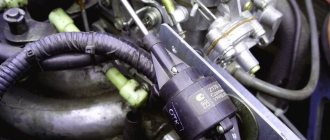Any car enthusiast, as well as a person who is just planning to buy a car, has heard about the concept of compression in engine cylinders.
Experienced car enthusiasts already know that compression in an engine and its value in different cylinders is an extremely important characteristic. Moreover, you should definitely pay attention to this parameter when purchasing a car, and also periodically check the compression during operation in order to avoid engine malfunctions.
In this article we will tell you what compression should be in a diesel engine, how to measure it, and how to prevent problems associated with it in advance. But first, a little about what compression is in a car engine.
Reducing compression in DSV
After inspection and diagnostics, we determined that some or all of the engine cylinders had low or no compression pressure. If its decrease is insignificant and falls within the specifications recommended by the manufacturer, we can continue to operate the vehicle, but we should gradually prepare to repair the power unit. If the indicators are critical, then it is quite obvious that such a power plant cannot be operated and must be urgently repaired.
In a garage (on your own), you can eliminate only one reason - the appearance of soot and coking in the compression rings with their subsequent formation. In other cases, disassembly of the motor with defect detection and replacement of components is required.
Decarbonization of compression rings
According to the recommendation of experts, before decoking it is necessary to pour 7-9 cm3 of engine oil into each of the problem cylinders, then repeat the compression pressure measurement. “If the situation with compression pressure has improved, then the rings may decarbonize. Otherwise, you should look for another opportunity and contact us,” say the service station employees.
Removing carbon deposits and coke from the piston rings does not help restore the desired pressure in all cases. But it is worth using this method because it requires minimal economic costs and a small loss of time.
To remove coke and carbon deposits from CPG parts, you should:
- Purchase an original cleaning fluid from a specialized store;
- Unscrew the spark plugs for gasoline engines and the glow plugs for diesel engines. Pour 35-50 grams of cleaner into each hole;
- Without screwing in the spark plugs, leave the car in the garage for about 12 hours;
- The engine must be cranked using the starter;
- The spark plugs are checked, cleaned and installed in their original place;
- We start and warm up the car;
- On an open highway, you need to accelerate the vehicle and drive at high speeds for 25-35 km
Upon arrival, it is advisable to repeat the measurements. If nothing has changed, then the decarbonization process did not lead to the expected results. And you should prepare for a big renovation.
It should also be noted that some car enthusiasts, trying to avoid expensive repairs, use all kinds of additives to restore parts. In fact, these additives contain the same components as decarbonizers, but the cost of these products, for obvious reasons, is much higher.
Truly original additives contain metal revitalizants - substances capable of forming a protective layer on the surface of mating units.
This approach can significantly complicate repairs and increase the cost of already quite expensive components.
Preventing Compression Pressure Loss
In this article we tried to cover the topic of why there is no compression in the engine, and how you can try to solve this problem. Since a motor has not yet been invented that will work forever, all its components wear out over time. But it is quite possible to increase the time of accident-free and repair-free operation of equipment.
If the vehicle has operated uninterruptedly for the number of hours allotted by the manufacturer, then its operation was correct, and time was the cause of the malfunction.
But a drop in compression and premature wear of parts on “fresh” engines is only the responsibility of their owners.
What needs to be done to increase the reliability of car components.
- Monitor the quality of the fuel, since its contamination is the main cause of coke formation in the compression piston rings with subsequent ring jamming.
- Using non-original and non-manufacturer recommended motor oil. This leads to increased wear of the liner-piston ring pair, since the rings move along the oil wedge, and its rupture leads to dry friction.
- Overheating leads to burnout of the cylinder head gasket and to more serious consequences, including engine destruction. Therefore, constant monitoring of the cooling temperature is necessary.
- Running at high speeds can cause the exhaust valves to burn out. Therefore, calmer driving should be recommended.
By following these simple rules, you can significantly increase the service life of your car's power unit.
The most popular reasons for decreased compression in a diesel engine
The problem with compression has several dozen main causes. Also, service centers often encounter individual structural features of a particular unit. Therefore, if you suspect poor cylinder compression, it is best to use the services of professionals and diagnose possible problems. This will save you money and time, and will help you recognize the reasons for engine loss of compression at an early stage. Please note that a diesel unit cannot always be restored after loss of compression. The most common causes of this problem are the following:
- incorrect valve adjustment, which causes uneven compression in different cylinders;
- wear of guide bushings, which also have a direct effect on compression;
- direct damage to the valve, possible burnout or mechanical impact;
- a crack in the cylinder block or head, which causes loss of compression;
- failure of the cylinder head gasket or disruption of the smoothness of its seating surface;
- wear of the piston group or cylinder walls, piston burnout, through holes in the internal part of the engine;
- heavy carbon deposits on the inside of the unit due to the use of extremely poor fuel.
All these problems can sooner or later arise in any diesel unit, so you should be careful in operation. As soon as the machine begins to show problems with compression, you should check the indicated components and get maximum efficiency of the unit. Often, the above reasons will be the basis for reducing compression and will help you understand what to do with the car and what repair work needs to be done.
Why the received data may differ from the passport data
The information obtained when measuring compression, as a rule, differs from the figures stated by the car manufacturer in technical documents. The discrepancy in values is due to wear on the piston group that occurs during regular use of the vehicle. With increasing wear of elements, compression in the cylinders of the power unit decreases.
Undoubtedly, with small deviations from the figures stated by the manufacturer, the car owner can continue to use the vehicle without repairing the piston group. A discrepancy of up to ten percent is considered acceptable. As the performance gap increases, the engine components are considered severely worn.
Engine compression measurement
To obtain information about the degree of engine wear, engine compression is measured. The procedure helps to detect breakdowns of car parts. Also, measuring the compression in the engine cylinders allows you to identify the presence of a faulty element. To perform diagnostics, a compression meter is used, which can be gasoline, diesel or universal. There is another device for measuring engine compression - a compression gauge, which is additionally equipped with a function for recording indicators.
Rating of the best diesel engines
Having studied the ratings of major car dealerships around the world, we can come to the conclusion that the best diesel engines for passenger cars are no longer smaller copies of truck units, but a full-fledged product. Just look at the durable 1.9 TDI engine from the well-known Volkswagen concern.
It comes in various modifications, does not conflict with local fuel, and in good hands runs about 500 thousand kilometers. Of course, a lot depends on proper maintenance and operating conditions, but still this model deserves attention.
Let's not ignore the brand new cars of the Passat series. They are now equipped with BlueMotion engines
The engineers did a great job, they managed to reduce fuel consumption despite the fact that the power did not change and varies from 90 to 120 (hp).
Now he spends only 3.3 liters. per 100 km. They achieved this by updating the turbine and increasing the pressure in the combustion chambers
They also began to pollute the environment much less, which is important in today’s conditions.
We also cannot ignore engines from Mercedes and Nissan - these are the most reliable engines; a little lower in our ranking we will place Subaru engines. But not only the Japanese and Germans have good diesel engines; for example, the Americans have a good engine from Ford
We'll put Opel on the next level. We’ll stop here, because there are too many complaints about Renault engines, and VAZ engines deserve a separate conversation about them.
What is compression in a diesel engine
Compression is an indicator of the pressure in the cylinder that is created by the piston at the maximum highest (dead) point of the stroke. In technical literature, it is customary to use the abbreviation TDC (highest dead center). The value is measured in kg/cm² and depends on two main factors:
- Violation of the tightness of the combustion chamber: air leaks, pressure in the system drops. Worn valves, cylinder-piston units, or incorrect adjustment of the gas distribution mechanism leads to a decrease in compression.
- Condition of the crankshaft and its rotation speed: loss of stable speed leads to heat losses when air is compressed by the piston. The compression ratio becomes lower than normal, which directly affects the energy that is generated as a result of the formation of working gases during the combustion of the fuel mixture in the cylinders.
Rapid wear of CPG mechanisms (cylinder-piston group) depends on the quality of lubricants, the intensity of loads during operation, the number of cold starts at sub-zero air temperatures and hours of operation at maximum speed. Incorrect adjustment of the valve system contributes to the formation of carbon deposits on the walls of the combustion chamber, cylinder liners, and coking of the piston and oil scraper rings. As a result of insufficient pressure, the fuel mixture does not burn completely and mixes with oil residues, leaving burning products and soot on the CPG units. The first sign of wear in this case is a smoky exhaust and a drop in engine power.
During startup and activation of the starter, the crankshaft in a diesel unit rotates at a speed of 200-300 rpm: the higher the torque, the higher the compression. If the pressure in the combustion chamber is below 16 atmospheres, then starting the diesel engine in the usual way with the key becomes impossible. Heat loss causes a decrease in the compression ratio and disruption of the valve timing adjustment.
Important! Prolonged operation of a diesel unit with incorrect operation of the gas distribution mechanism leads to failure of the entire cylinder block. Up to the jamming of the pistons without the possibility of restoration and major repairs.
This is interesting: Where is the car's VIN code?
A little about geometry
Often, even experienced experts and mechanics confuse the definition of compression and the actual compression ratio, but in reality these are completely different things and all this should be understood in detail.
As for the degree of compression, this value is relative and does not have any strictly defined unit of measurement. The fact is that this indicator includes two characteristics, that is, the volume of each cylinder and the combustion chamber itself. It can show in what proportion the volume and pressure of the fuel mixture or gases will decrease at the moment when the piston rises up.
If you pay attention to the characteristics of modern engines, then most often manufacturers indicate their compression ratio. This characteristic clearly indicates the perfection of the design, as well as the level of boost
The compression ratio and the compression ratio are inextricably linked. It is easy to understand that the compression ratio will be greater if the compression is not lower than it should be. You can find out what it should be like for a particular motor from its technical characteristics. No difficulties would arise if heating of the mixture, changes in oil pressure and other factors were not present during operation of the power unit.
What to do if the compression of a diesel engine is greatly reduced?
If your power unit has severely reduced compression, you should contact a service station with a request to diagnose the engine. Most often, with a serious decrease in this indicator, as well as with a high mileage of the car, we are talking about physical wear and tear. In this case, you need to decide whether it would be advisable to carry out a major overhaul of the unit. Many modern diesel engines have gained the reputation of being “disposable”, that is, the thinness of the cylinder walls does not allow for major overhauls. Therefore, the sequence of actions when poor compression is detected should be as follows:
- cessation of operation of the car - if we are not talking about wear and tear of the vital organs of the engine, further operation will make repairs more expensive;
- Carrying out high-quality professional diagnostics that will tell you everything about the causes of the problem and ways to eliminate it;
- deciding which troubleshooting method will be chosen, as well as where and how your power unit will be repaired;
- purchasing parts that are necessary for restoration work, checking the quality of all purchased items;
- handing over the machine to a master who performs specific work on major engine repairs, waiting for the completion of repair work;
- checking the car through a thorough study of visual and sound features of operation, testing on the road with measuring fuel consumption.
This is what a major overhaul of a diesel power unit that has lost the necessary compression looks like. Almost all engines that are installed in modern passenger cars are very expensive to repair. Therefore, there is another option for restoring the operation of the power unit. This is the purchase of a contract engine - a used power unit with low mileage, imported from another country. Such an engine will make your car practically new, but its official registration today involves significant difficulties.
We invite you to watch the video of the process of measuring compression in the Volvo XC90 power unit:
So, diesel engine.
One of the most undeniable advantages of a diesel engine is lower fuel consumption, approximately 20-30% lower than that of a gasoline engine. The air compression ratio in a diesel engine is 20 units, while in a gasoline engine no more than 10 units are achieved. Another important advantage of a modern diesel engine is its higher environmental friendliness. In addition, diesel fuel evaporates less rapidly than gasoline, which reduces the likelihood of fire. With an identical engine size, the maximum power is greater for the gasoline engine, however, the torque is much lower than for its diesel counterpart.
A significant disadvantage of diesel, which worries most car enthusiasts, is the complexity of maintenance and repair. It’s quite difficult to find a car service center willing to take on work with a thinner diesel engine mechanism. In addition, the interval between maintenance for a diesel car is much lower, and its price is higher. This drawback can become a serious obstacle when choosing a diesel engine, but only if you need the car for short-term use and short distances. Diesel performs well and pays for itself in cases where you plan to own the car for a long time or you need a reliable “iron horse” on long journeys. Another disadvantage of diesel fuel is its low frost resistance. Regular diesel fuel quickly thickens in the cold and the car refuses to start. If you live in a region where sub-zero temperatures are common, you will have to stock up on special “winter” diesel fuel or know exactly at which gas stations you can find it in the winter. Also, if we continue the theme of frost, a disadvantage of a diesel engine can be called slow warming up.
Algorithm for measuring pressure in cylinders
It is necessary to check compression after thoroughly warming up the engine. When measuring the pressure in the pistons, a device called a compression meter is used, which has a special pressure gauge scale for displaying information and a thread designed to be screwed in instead of glow plugs or injectors.
The sequence of actions consists of performing the following operations:
- Removing the glow plug or injector from one of the cylinders.
- Installing the measuring device in place of the removed spark plug or injector.
- Rotating the crankshaft using a starter.
- Recording the obtained result.
- The pressure in the remaining cylinders is measured using similar actions.
- Reconciliation of the obtained results.
- Add 50 ml of oil to each piston using a medical syringe.
- Cranking the engine with the spark plugs removed using the starter.
- New compression tester.
- An increase in this indicator indicates problems that have arisen in the piston group.
- If the pressure remains unchanged, then it is necessary to make repairs and adjustments to the valve mechanism.
To obtain real results when carrying out control measurements, it is necessary to ensure the required number of crankshaft revolutions equal to 200–250 rpm.
What should be the pressure in the cylinders?
For gasoline engines, the normal compression ratio is 9-11 and 12-13 kg/cm2, respectively; for diesel engines, the norm is 20 or more and 20-32 kg/cm2.
As you can see, the metrics are very different, and therein lies the difference in their workflow. Low ambient temperatures can be a serious problem. Different pressure ratings can provide starting at different temperatures:
It should be noted that such temperature ranges on a diesel engine are only achievable with a fully operational power unit and auxiliary equipment.
We evaluate the results obtained
After completing all measurements, we analyze the readings for the cylinders. If the spread across the cylinders is up to 1 atmosphere, then the engine malfunction is not related to compression. The problem should be looked for in the injection, ignition, fuel supply systems, etc. A scatter indicator of just over 1 atmosphere will indicate that the CPG is wearing unevenly, but the condition is acceptable.
The approximate compression ratio should be equal to the compression ratio, which is multiplied by 1.3. The compression ratio values for a specific engine are found in the vehicle technical manual, instructions or repair manual.
For gasoline internal combustion engines, which are designed for 76 or 80 gasoline, the compression on a hot engine should be at least 9.5-10 atmospheres (taking into account a working cylinder-piston group). The required indicator for modern engines (gasoline grade AI-92 and higher) is 11-14 atmospheres with an acceptable spread across the cylinders of up to 1 atmosphere. A diesel engine implies a compression from 28 (for older generations of diesel internal combustion engines) to 45 atmospheres (modern diesel) with a spread across the cylinders of up to 3 atmospheres.
The compression indicator is calculated approximately, as it depends on the temperature of the internal combustion engine during measurements, the viscosity of the engine oil, the condition of the battery, and others. It is also worth taking into account the error in the compression meter readings, which in some cases is about 3 atmospheres.
The basis should be a comparison of readings by cylinder. It is a mistake to believe that only a low compression reading will clearly indicate a malfunction. It happens that there is excessive oil penetration into a faulty cylinder. Excess oil increases compression, thereby masking the problem. In this case, you need to carefully analyze the condition of the engine spark plugs. If there are traces of oil deposits at acceptable compression, then the cause of oil ingress may be a broken oil scraper ring, wear of the valve bushing (guide), etc.
- What compression should be in a diesel engine?
Diesel engine compression indicator. The main reasons and main signs of decreased compression. Starting the engine with insufficient pressure in the cylinders. Read more
- Breather oil: cause and solution to the problem
Why oil leaks from the engine breather: signs and main causes of such a malfunction. How to understand why oil is flowing through the breather, troubleshooting. Read more
- Engine additive to increase compression
Low compression in engine cylinders: the main reasons. How to increase engine compression without engine repair, available methods. Tips and tricks. Read more
- Low compression in a diesel engine
Problems starting a diesel engine. Signs of low compression and causes of malfunction: timing belt, cylinder mirror, piston and rings. We measure the compression. Read more
- Diagnostics of diesel engines: fuel system…
Common diesel engine malfunctions and diagnostics of units of this type. Checking the fuel system of a diesel engine, useful tips. Read more
- Oil leakage from under the oil filter: reasons...
Causes of oil leaks in the oil filter area: oil flows from under the filter, through the housing, in the area of the fitting, etc. Available diagnostic and repair methods. Read more
How to measure compression in an engine?
This is done using a special device called a compression gauge. It is a pressure gauge, usually operating at a pressure of up to 60 atmospheres, to which is attached a special adapter made in the form of a glow plug or nozzle. Accordingly, you need to insert the compression gauge into the hole from the unscrewed nozzle.
That's all we wanted to say on this issue. We hope that our article was useful to you and gave a comprehensive answer to the question of what compression should be in a diesel engine. Do not neglect the maintenance of your engine, and then it will delight you with its performance for many years!
New articles
- What to do if rings are stuck in the engine? Three methods for decoking
- What is the difference between 5w40 oil and 10w-40?
Pro tips: engine compression additive, whether to use it or not
Undoubtedly, special additives can increase the compression of the power unit, since they have a lot of positive complex properties. However, you need to understand that you should not expect a significant effect from additives if the engine is severely worn out. By the way, there are a number of negative reviews among car owners after use. In any case, the choice is yours.
What parts need to be lubricated?
The chain is the most moving part of the chainsaw, which wears out, constantly coming into contact with the bar and sprocket. Lubrication helps reduce friction between components, reduces temperature and prevents rapid wear of parts. Lubricant is supplied automatically to the moving parts of the saw from a special tank.
Be sure to lubricate the pistons and crankcase as well. Lubricants enter it along with fuel.
Thick oil with a high degree of adhesion to the surface is suitable for the chain, and special machine oil for the motor.
Compression measurement on a diesel engine
Diesel compression is measured when the diesel engine has become poor or “hot” without other obvious reasons. The compression measurement of a diesel engine is carried out after eliminating malfunctions of the fuel supply system, starter, battery, glow plugs and other elements.
A diesel engine in good condition has a compression of approximately 30 kg/sq. see. The diesel engine starts relatively normally with a compression rate of up to 24 kg/sq.m. see. Compression measurement of a diesel engine is carried out through the spark plug wells of the glow plugs. The second way to measure the compression of a diesel engine is to unscrew the fuel injectors. To measure diesel compression, you must have a compression gauge (special pressure gauge) and follow the following recommendations:
- Warm up the diesel engine to operating temperature, since on a cold internal combustion engine the working fuel-air mixture does not have the ability to expand when heated. The result will be reduced diesel compression when measured “cold”.
- The throttle must be fully opened, releasing the throttle control to maximum. Opening the throttle valve will allow the engine combustion chamber at TDC of the piston stroke to be completely filled with the working mixture. If this requirement is not taken into account, then a vacuum will be created, compression will occur at a lower pressure compared to atmospheric pressure. The result will be an incorrect reading and the compression will be too low.
- For multi-cylinder internal combustion engines, it is necessary to unscrew the glow plugs from all cylinders of the engine. This is necessary so that the energy supplied from the starter to the engine crankshaft is not wasted on compressing the fuel-air mixture in those cylinders where compression is not measured. Ignoring this aspect will result in a lower compression reading in the cylinder being tested.
- You need to measure diesel compression from the starter. The battery must be properly charged. Slow rotation of the engine crankshaft means that gases from the working chamber will partially break through the locks of the rings, as well as through the cracks from the incomplete fit of the valves. The result is that the compression ratio is underestimated.
- Using a kick starter and strong rotation of the crankshaft will lead to shock compression, in which the compression of the diesel engine will be overestimated.
This is interesting: Condensation in a car - what causes the windows to sweat and ice to form?
What affects the compression of a diesel engine?
Before you begin checking the most important indicator that characterizes the correct or impaired function of a car engine, you need to understand what factors change the amount of compression.
The amount of air loss during engine operation is directly proportional to the reduction in compression. This indicator depends entirely on the serviceability of the CPG and valves. The compression characteristics completely depend on the tightness of the system and the period of passage of the air flow, which is determined by the speed of the shaft. When the CPG is in poor condition, compression values will decrease.
The second argument affecting the compression of a diesel engine is the amount of heat loss. This factor is determined by the size of the walls with which the air flow interacts. At a higher rotation speed of the crankshaft, the air flow does not contact the surface of the walls for so long and, accordingly, loses less heat. Reducing heat transfer time maintains airflow characteristics and increases compression.
Many car enthusiasts know and remember the importance of the amount of air loss relative to engine compression. But not everyone takes into account the importance of heat loss for compression. And of course, the importance of the crankshaft rotation speed cannot be overlooked.
Diagnosing faults
After taking measurements in all cylinders, you should pay attention to two points. The first is whether the measured compression corresponds to the minimum permissible value
The first is whether the measured compression corresponds to the minimum permissible value.
It is determined by the engine developers and is indicated in the repair manual.
The second is the difference in compression values in different cylinders of the same engine.
As a rule, it should not exceed 20% of the nominal value.
If you find that the pressure in any of the cylinders is below normal, inject three portions of oil into it from a manual oil can.
Do not inject more than three portions of oil, as excess oil can lead to the formation of a hydrostatic plug, which can cause breakage of the rings, piston, or even lead to a crack in the cylinder head.
The oil will seal the gap between the rings and the cylinder, and if the reason for the low compression was in this gap, then with such a “wet” test the compression should increase significantly.
Then check the condition of the rings, and if one of them is damaged or stuck, replace it.
If compression behaves this way in all cylinders, then it’s probably time for a serious repair with boring the cylinders and installing rings of the next repair size.
The effect of additives that increase compression is based on the effect of sealing gaps, similar to an oil wedge.
This is the easiest way to restore to some extent the former agility of the engine.
Only in this case you need to remember that their effect is quite short-lived, and repeated use no longer has such an effect.
Therefore, this method is often used before selling a car, so as not to spend money on expensive engine repairs.
If, after injecting oil into the cylinder, the compression changes slightly, then most likely the reason for its drop is a malfunction of the valve group or a broken cylinder head gasket.
From all that has been said, another conclusion follows: low, but approximately equal in all cylinders, compression indicates natural wear of engine parts, but a sharply different drop in one or more cylinders indicates a malfunction.
Sometimes damage or wear to the oil ring can cause compression to rise above the values set for a new engine.
This occurs because the worn ring does not remove excess oil from the cylinder walls, and it seals the gap between the cylinder and the compression rings, and then, during the power stroke of the piston, the oil burns out, forming carbon deposits on the cylinder head.
If this process continues for a long time, then the carbon layer becomes so significant that it leads to a decrease in the volume of the combustion chamber, and therefore to an increase in compression.
This phenomenon is dangerous due to engine detonation. It also leads to increased oil consumption.
Signs of decreased compression
The unit of measurement for engine compression is the atmosphere, and the compression pressure in the cylinder can also be calculated in pascals, kilograms per centimeter. If the numbers obtained during diagnostics correspond to the technical characteristics declared by the manufacturer, then the motor operates in optimal mode.
A decrease in compression level is manifested in the following symptoms:
- fuel consumption increases;
- black or blue exhaust smoke appears;
- while moving, pops and blows are heard;
- the car is difficult to start;
- the valve is deformed;
- the air filter becomes clogged;
- cracks appear in the cylinder head;
- The engine runs unsteadily at low speeds.
If these signs are detected, it is necessary to diagnose the vehicle.
